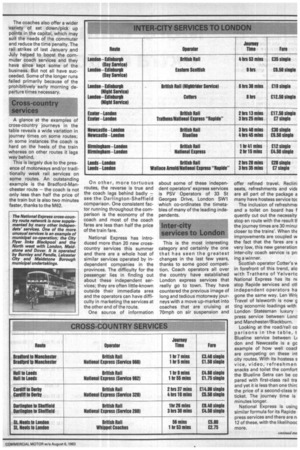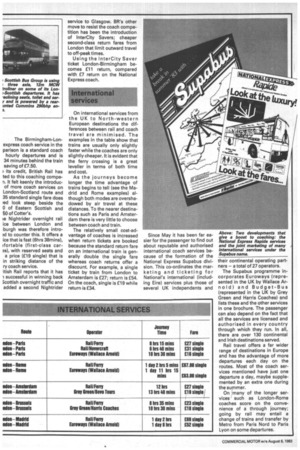More training or extra coaching?
Page 40

Page 41

Page 42

If you've noticed an error in this article please click here to report it so we can fix it.
e you going off the rails hen you choose to go by 3in7 David Wilcox has been ading through the timebles to see how coach serces compare with the 3ins when it comes to leed and fares, from a -mile commuter run into Indon to an international rvice to Rome
IS Jimmy Savile versus leper the cartoon frog and his aching chums. It is Waterloo rsus Victoria Coach Station. It Cheltenham versus Crewe. In oil, how does coach travel ape up alongside rail travel? Dyer the past few years corntition between the two modes s intensified on all fronts, arked off by the Transport Act 80 which came into force on :tober 6 that year. This effectily deregulated express ser;es over 30 miles — Road Sere Licences no longer became cessary — opening the way
all coach operators to try 3ir hand at express services. The Act also made it easier to ,tain a Road Service Licence stage services under 30 les. As a potential objector to y new stage service British ii would have to prove the sere was against the public in-est.
These changes have not only to new coach services but ve also coincided with a move 1-market. The coaches themIves have reached new stani rds of luxury and their echanical specification is milarly improved. The lerator who, three years ago )uld have been proud of a twoar-old Plaxton Supreme-boad Leyland Leopard is now to seen in Neoplans and Setras d the like.
Comparing the comfort of a ach and a train is difficult. are is no standard coach or mdard train and it is largely a bjective matter. But you can mpare journey times and -es, which are the deciding fac^s for many travellers.
In trying to make a fair and [jective assessment of times d fares I have taken five )ical journeys on each of four )es of route. In each case I ye tried to compare like with e. For example, if the coach -ives at 10.30am I have cornred it with the train service 3t arrives at a similar time.
-he comparison of fares also ads careful attention. Since definition of day return ies (on coaches it generally
;ans out and back any time on same day whereas on trains outward journey is normally stricted to after the peak hours) in most cases I have taken a second-class single fare as the basis for comparison.
Coach return tickets generally seem to offer better discounts than their rail equivalents but British Rail can counter with a staggering range of specialist fares for different sections of the community (Young Person's Railcard, Family Railcard, Senior Citizen Railcard, etc).
As will be seen, while coaching has been on the up and up in :the last few years British Rail has not been entirely idle. Its current annual report notes that passenger journeys in 1982 were down to 630m, a fall of about 10 per cent on the previous year.
Although the report does mention "keen competition from long distance coaches" much of this traffic loss must be regarded as self-inflicted — BR suffered from 34 days of strikes last year, equal to almost 10 per cent of their potential operating period. coaches have begun to offer a limited alternative. This is mainly a South-eastern phenomenon with most of the commuter coach services running into London along corridors where BR is not at its strongest.
The commuter coach services vary in character. Some are part of a regular service (usually by an NBC subsidiary) that has recently responded to the needs of commuters with extra departures or connections timed to suit commuters' arrival and departure times in London.
Others, such as the Epsom Coaches example shown, are by independent operators and are typically just one departure into London in the morning and one return journey in the evening. This fits in nicely with their other work; the coach is free in London during the day for sightseeing or tourist work.
Municipal operators have also seen the opportunity for commuter runs; Southend and Reading are two notable municipal undertakings that have commuter services into London.
Looking at the examples of commuter runs, the train's advantage in journey time is ob vious; London's traffic congestion see to it that coaches are taking up to twice as long. The train also scores on frequency of departure.
But equally obvious is the tremendous cost saving offered by the coaches, an important point for the daily commuter. Season ticket savings are applicable to both modes. A guaranteed seat on the coach is another point in its favour, compared with the possibility of standing on the train. The coaches also offer a wider variety of set down/pick up points in the capital, which may suit the needs of the commuter and reduce the time penalty. The rail strikes of last January and July helped to boost the commuter coach services and they have since kept some of the business. But not all have succeeded. Some of the longer runs failed primarily because of the prohibitively early morning departure times necessary.
A glance at the examples of cross-country journeys in the table reveals a wide variation in journey times on some routes; in some instances the coach is hard on the heels of the train whereas on other routes it lags way behind.
This is largely due to the presence of motorways and/or traditionally weak rail services on some routes. An outstanding example is the Bradford-Manchester route — the coach is not only less than half the price of the train but is also two minutes faster, thanks to the M62.
On other, more tortuous routes, the reverse is true and the coach lags behind badly 7 see the Darlington-Sheffield comparison. One consistent factor running throughout the comparison is the economy of the coach and most of the coach fares are less than half the price of the train fare.
National Express has introduced more than 20 new crosscountry services this summer and there are a whole host of similar services operated by independent companies in the provinces. The difficulty for the passenger lies in finding out about these independent services; they are often little-known outside their immediate area and the operators can have difficulty in marketing the services at the other end of the route.
One source of information about some of these independent operators' express services is PSV Operators of 33 St Georges Drive, London SW1 which co-ordinates the timetables of many of the leading independents.
This is the most interesting category and certainly the one that has seen the greatest changes in the last few years, thanks to some good competition. Coach operators all over the country have established London express services that really go to town. They have countered the previous image of long and tedious motorway journeys with a move up-market into coaches that are cruising at 70mph on air suspension and offer refined travel. Reclini seats, refreshments and vidE are all part of the package a many have hostess service toc The inclusion of refreshmei and a toilet on board has f quently cut out the necessity stop en route with the result ti the journey times are 30 minui closer to the trains'. When thE improvements are coupled w the fact that the fares are s very low, this new generation inter-city coach service is prc ing a winner.
Scottish operator Cotter's N.4 in forefront of this trend, alo with Trathens of Yelverto National Express has its nr stop Rapide services and oit independent operators ha gone the same way. Len Writ Travel of Isleworth is now g ting economic loadings with London Statesman luxury press service between Lond and Manchester/Blackburn.
Looking at the road/rail co parisons in the table, t Blueline service between Li don and Newcastle is a gc example of how well cowlare competing on these int city routes. With its hostess s vice, video, ref reshmen snacks and toilet the comfort the Blueline Setra can be co pared with first-class rail tra and yet it is less than one thirc the price of a second-class tr ticket. The journey time is minutes longer.
National Express is using similar formula for its Rapide press services and there are n. 12 of these, with the likelihooc more, The Birmingham-Lonexpress coach service in the parison is a standard coach hourly departures and is 34 minutes behind the train saving of £7.50.
) its credit, British Rail has ted to this coaching compel. It felt keenly the introducof more coach services on London-Scotland route and 35 standard single fare does .ed look steep beside the 0 of Eastern Scottish and 50 of Cotter's.
le Nightrider overnight rail ice between London and burgh was therefore introKi to counter this. It offers a ice that is fast (6hrs 38mins), ifortable (first-class cares), with reserved seats and a price (£19 single) that is in striking distance of the ry coach service.
itish Rail reports that it has successful in winning back 3cottish overnight traffic and added a second Nightrider service to Glasgow. BR's other move to resist the coach competition has been the introduction of InterCity Savers; cheaper second-class return fares from London that limit outward travel to off-peak times.
Using the InterCity Saver ticket London-Birmingham becomes £11 return, compared with £7 return on the National Express coach.
On international services from the UK to North-western European destinations the differences between rail and coach travel are minimised. The examples in the table show that trains are usually only slightly faster while the coaches are only slightly cheaper. It is evident that the ferry crossing is a great leveller in terms of both time and cost.
As the journeys become longer the time advantage of trains begins to tell (see the Madrid and Rome examples) although both modes are overshadowed by air travel at these distances. To the nearer destinations such as Paris and Amsterdam there is very little to choose between coach and train.
The relatively small cost-advantage of coaches is increased when return tickets are booked because the standard return fare on an international train is generally double the single fare whereas coach returns offer a discount. For example, a single ticket by train from London to Amsterdam is £27; return is £54. On the coach, single is £19 while return is £34. Since May it has been far easier for the passenger to find out about reputable and authorised international coach services because of the formation of the National Express Supabus division. This co-ordinates the marketing and ticketing for National's international (including Eire) services plus those of several UK independents and their continental operating partners — a total of 27 operators.
The Supabus programme incorporates Euroways (represented in the UK by Wallace Arnold) and Budget-Bus (represented in the UK by Grey Green and Harris Coaches) and lists these and the other services in one brochure. The passenger can also depend on the fact that all the services are licensed and authorised in every country through which they run. In all, there are over 130 continental and Irish destinations served.
Rail travel offers a far wider range of destinations in Europe and has the advantage of more departures each day on the routes. Most of the coach services mentioned have just one departure a day, maybe supplemented by an extra one during the summer.
On !many of the longer services ' such as London-Rome coaches score on the convenience of a through journey; going by rail may entail a change of trains and transfer by Metro from Paris Nord to Paris Lyon on some departures.
































































































